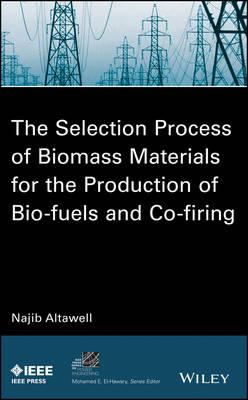Overview
A functional discussion of the crop selection process for biomass energy The Selection Process of Biomass Materials for the Production of Bio-fuels and Co-firing provides a detailed examination and analysis for a number of energy crops and their use as a source for generating electricity and for the production of bio-fuels. Renowned renewable energy expert and consultant Dr. Najib Altawell begins with the fundamentals of bio-fuels and co-firing and moves on to the main feature, which is the methodology that assists energy scientists and engineers to arrive at the most suitable biomass materials tailored to each company’s business and economic environments and objectives. This methodology provides a framework whereby power-generating companies can insert their own values for each factor, whether business factor (BF) or scientific & technical factors (S&T) or both simultaneously. The methodology provides a list of factors related to the biomass energy business. The average values have been obtained from the survey method and laboratory tests. These values are the standard values power companies can use if they need or wish to use them. The Selection Process of Biomass Materials for the Production of Bio-fuels and Co-firing has been designed and compiled for the widest possible range of readers, researchers, businesspeople, and economists who are connected to the renewable energy field in general, and biomass energy in particular. Because of its focus on practical data and applications, the book is also accessible for general readers who may or may not have a technical or scientific background.
Full Product Details
Author: N. Altawell
Publisher: John Wiley & Sons Inc
Imprint: Wiley-IEEE Press
Dimensions:
Width: 16.00cm
, Height: 2.80cm
, Length: 23.60cm
Weight: 0.726kg
ISBN: 9781118542668
ISBN 10: 1118542665
Pages: 378
Publication Date: 06 June 2014
Audience:
Professional and scholarly
,
Professional & Vocational
Format: Hardback
Publisher's Status: Active
Availability: Out of stock

The supplier is temporarily out of stock of this item. It will be ordered for you on backorder and shipped when it becomes available.
Reviews
<p> Because of its focus on practical data and applications,the book is also accessible for general readers who may or may nothave a technical or scientific background. (Landtechnik, 1 September 2014)
?Because of its focus on practical data and applications, the book is also accessible for general readers who may or may not have a technical or scientific background.? (Landtechnik, 1 September 2014)
Because of its focus on practical data and applications, the book is also accessible for general readers who may or may not have a technical or scientific background. ( Landtechnik , 1 September 2014)
Author Information
NAJIB ALTAWELL, PhD, is a researcher, consultant, and lecturer in renewable energy, specializing in commercial and technical aspects of biomass. He earned his PhD in Environmental Engineering from the University of Nottingham (2010), MRes in Nanotechnology and Nano-electronics from Surrey University (2004), BSc (Hon) in Computer Science from Westminster University and Kingston University (2001), and PGC/PGD in Teaching from Kingston College (2002).



